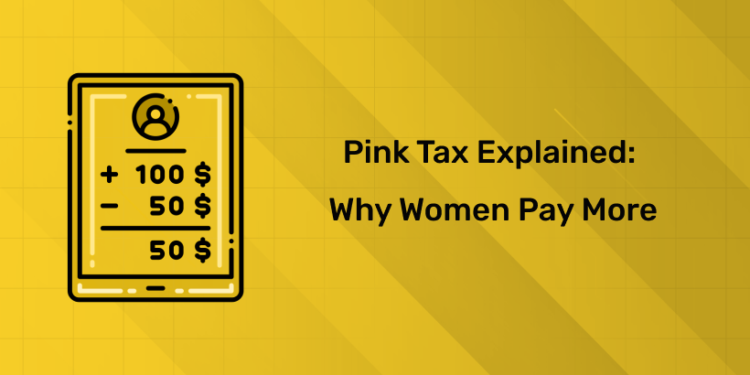Table of Contents
Introduction
Imagine you walk in a store and purchase a razor. The blue one for men is $2. The pink model costs $3, as the blades are the same. It is not rare. Every day. This cost difference is known as the pink tax, which equates women to higher prices for basic products.
These small markups add up quickly. Over one year, the extra costs can exceed $1,300. The average life expectancy is around $188,000. The pink tax illustrates how companies charge women more in changing colors, packaging or marketing. There are a difference between the products and functions but they all work the same. Men often pay less, while women do. That’s unfair, and it impacts financial stability and equality.
Why bother? Because prices continue to rise in 2025 and women are already doing less at the rate of earning less on average. If men earn as much as $8, the gap is about 82 cents in earnings per dollar. If the pay gap and pink tax combine with this pay gap, the financial pressure becomes deeper. Bills become larger. Savings fell. The effect is affecting families. But understanding the problem is the first step to protecting yourself. When you know how it works, you can predict the patterns and avoid unnecessary expenses.
This post describes how to calculate the pink tax. It defines what it is, the major industries affected, what makes it happen and an example table. There will also be a study of how that affects everyday shoppers and how to avoid paying too much. The goal is to understand the issue and act.
What is Pink Tax?
1: Accounting provides information on
The pink tax refers to higher prices placed on products marketed to women. These products usually work the same as the versions sold to men, yet they cost more. Companies often make small changes—like pink colors or floral designs—and use that to justify a higher price. That’s where the term “pink tax” comes from. It isn’t a real government tax. No law adds it at checkout. The pricing comes from companies deciding that women will pay more.
Most differences are cosmetic. A razor in a blue pack shaves the same as one in a pink pack, but women pay about 11% more on average. The same pattern shows up in deodorant. Men’s and women’s sticks serve the same purpose, yet the price gap can reach 44%. This isn’t new. Years ago, marketers assumed women cared more about appearance and would spend extra. Over time, this thinking spread across product lines—from toys to personal care items.
The pink tax links to gender bias. Society pressures women to maintain a certain standard of grooming. Advertising reinforces this message, and companies profit from it. Men are not targeted in the same way, so they avoid many of these markups. Studies across the US, Europe, and Asia show a similar pattern, and the UN has called for reducing these pricing gaps because they affect women’s economic opportunities.
The issue isn’t limited to products. Services often cost more for women too. Dry cleaning a woman’s shirt can cost more than cleaning a man’s shirt, even if the fabric is similar. Haircuts follow the same pattern. Short haircuts for women are often priced higher than comparable cuts for men.
Some regions also tax feminine hygiene products such as pads and tampons. They are essential items, but in many places they still face regular sales tax, as if they were non-essential goods. One particular state and country has began with the removal of these taxes. For example, California bans the pink tax on goods and services, as others are considering it.
In general, the pink tax creates hidden costs that over time increase a woman’s life. It contributes to inequality of financial pressure and widifies gendered gaps. The attention on this issue has grown significantly in 2025. More people are able to understand that this bias is often present in social media posts, price comparisons, and personal accounts. The term “pink tax” was first brought up in the 1990s as a result of persistent prices differences. The pattern has been confirmed since then and is a vital issue in the discussion of gender rights.
The pink tax shows how bias can be silent when shopping. Knowing that is the first step. When people see it, they can avoid overpriced products, call on unfair prices and push for better policies.
Placement Oriented PWC Business Accounting Course
PWC Certified Business Accounting Course by Entri App: Master in-demand skills, ace interviews, and secure top-tier jobs.
Join Now!Common Industries Affected by Pink Tax
Many everyday products and services still cost women more. Personal care items are a major example. Shampoos, conditioners, and body washes marketed to women usually include added scents or promises of shine, and the prices rise about 13 percent compared to basic men’s versions. Razors and blades show the same pattern. Women’s packs cost more per unit, and even the refills carry a markup. One study found a consistent 10–15 percent increase. Deodorants follow the trend, with women’s sprays and sticks priced higher than men’s.
Skin care also shows a clear gap. Lotions, creams, and face washes packaged in pink bottles promise softness, while the blue versions simply claim to clean. The women’s versions usually cost more.
Clothing brings even bigger differences. Women’s jeans often cost more than men’s, even when they use similar denim with only small changes in fit. The same happens with shirts, socks, and underwear. Dry cleaning adds to the imbalance. Women’s blouses typically cost $5–7 to clean, while men’s shirts fall between $2–4, even when the fabric and care needs are similar.
The pattern starts early. Toys marketed to girls often come with higher price tags. Pink bikes or scooters cost more than the same models in blue. Dolls are often priced above action figures made from the same materials. Children learn the cost of gender from a young age.
Health products show the same issue. Pain relievers marketed for period symptoms usually cost more, even though the ingredients match standard painkillers. Vitamins marketed to women add features like extra iron and charge more, while men’s versions remain cheaper.
Auto services also show bias. Women often receive higher quotes for repairs, oil changes, and tire replacements. Some reports show price differences of up to 20 percent, based only on assumptions about how much the customer knows.
Hair care services widen the gap further. Women’s haircuts often start around $50, while men’s cuts may cost $20, even when the hair length and effort are similar. Color treatments and styling add even more cost.
Toiletries show subtle differences too. Even basic items like toilet paper sometimes cost more when sold in packages branded for women, though the product inside is the same.
The pattern continues with kids’ clothing. Girls’ outfits and school uniforms often cost more than boys’, even when the fabric and sizes match. Skirts, for example, may be priced higher than pants.
Some financial services add gender-based differences as well. Credit cards marketed with “women’s perks” sometimes come with extra fees. In rare cases, loans have been offered at slightly higher rates for women, though many laws now aim to prevent this.
Home goods show similar gaps. Cleaning supplies in floral scents target women and cost more. Even tools, like pink hammers, often carry a higher price than standard versions.
Fitness and lifestyle products repeat the pattern. Women’s yoga pants often cost more than men’s sweatpants made from similar materials. Some gyms charge extra for classes that are marketed toward women.
Food and beverages follow suit. Diet drinks targeted at women tend to cost more even though the ingredients and calories match the regular versions.
Travel accessories show the same split. Luggage in pink shades often costs more than standard colors. Toiletry kits marketed to women also come at higher prices.
Electronics and accessories add to the list. Phone cases in pink or “feminine” designs often have higher price tags than neutral versions with the same build quality.
By 2025, online shopping makes these differences easy to see. Price comparisons show clear patterns. Awareness helps consumers spot these markups, and choosing alternatives can reduce the impact. Companies rely on old habits, but informed choices help break the cycle.
Why Does Pink Tax Exist?
Companies profit from gendered marketing. They label products as “for women,” add pink designs, floral elements, and soft language, then raise the price. Many women assume these items are better, which keeps the demand steady. Gender roles influence this behaviour. Society teaches women that they need beauty and personal care products, while men only need basic items. Advertising reinforces these ideas. Women feel pressure to maintain their appearance, and they often end up paying more because of it.
A lack of information makes the problem worse. Most shoppers don’t compare products between aisles. The men’s section usually has cheaper options, but women often stick to what they already know and miss the savings. Supply chains add small costs—such as pink dyes or decorative packaging—but these increases are minor. They do not justify the higher price tags. Profit is the real driver.
Companies also know that women purchase more personal care products. They raise prices accordingly. Men buy fewer items, so brands offer them cheaper options. Laws allow this difference. There is no strict ban on gender-based pricing. A few places, like New York, have started investigations, but progress is slow. These patterns have deep historical roots. For decades, advertising portrayed women as homemakers and primary spenders for families, while men were shown as providers. These habits became normal. Competition is weak because most brands follow the same pricing strategy. They charge more for the pink version, and no major brand undercuts the trend. Research shows that women tolerate higher prices, sometimes because they perceive the products as higher quality or more suitable. Companies use this to their advantage.
By 2025, social media has increased awareness, but companies react quickly. They release new “women’s formulas” that are nearly identical to existing products but cost more. Economic inequalities also play a role. Women often earn less but spend more on essential items. This cycle keeps the gap in place. Design choices add to the issue. Products marketed to women often include extra features or aesthetic changes, and the added cost is passed to the buyer.
Shopping habits differ as well. Women tend to browse longer and may make impulse purchases. Men usually shop faster and choose basic, cheaper options. Store layouts support these patterns by placing pink items in prominent locations. Even global trade affects pricing. Many of these products are manufactured in low-cost regions, yet the final markups remain high. Taxes make it worse. In some countries, menstrual products are still taxed as non-essential goods, pushing prices higher.
Overall, the issue is a mix of cultural norms, business strategies, and legal gaps. Real change requires action from consumers, governments, and companies.
Real-World Examples of Pink Tax
Real examples show the pink tax in action. The table below lists common items. It compares prices for women and men. It shows the gap. These come from stores and studies in 2025.
| Item | Women’s Version | Men’s Version | Price Gap | Notes |
| Razors | Gillette Venus: $10 for 4 blades | Gillette Fusion: $8 for 4 blades | $2 more | Same blades, different color |
| Deodorant | Dove Women: $5.50 for 2.7 oz | Dove Men+Care: $4 for 2.7 oz | $1.50 more | Same protection, different scent |
| Shampoo | Pantene for women: $6 per bottle | Head & Shoulders for men: $4 per bottle | $2 more | Same clean effect |
| Toys | Lego Friends set: $30 | Lego City set: $25 | $5 more | Similar pieces, pink theme |
| Kids’ Bikes | Pink Huffy: $120 | Blue Huffy: $100 | $20 more | Same frame and wheels |
| Jeans | Women’s Levi: $60 | Men’s Levi: $50 | $10 more | Same denim, slight fit change |
| Underwear | Women’s Hanes pack: $15 for 6 | Men’s Hanes pack: $12 for 6 | $3 more | Same cotton |
| Dry Cleaning | Woman’s blouse: $7 | Man’s shirt: $3 | $4 more | Same pressing |
| Haircut | Women’s bob: $40 | Men’s trim: $20 | $20 more | Similar time |
| Pain Meds | Midol: $8 | Generic ibuprofen: $5 | $3 more | Same drug |
| Vitamins | Women’s One A Day: $10 | Men’s One A Day: $8 | $2 more | Close nutrients |
| Scooters | Pink Razor: $35 | Black Razor: $30 | $5 more | Same build |
| Pens | Bic for Her: $3 pack | Regular Bic: $2 pack | $1 more | Same ink |
| Luggage | Pink suitcase: $80 | Gray suitcase: $70 | $10 more | Same size |
| Yogurt | Women’s low-fat: $1.50 | Plain: $1 | $0.50 more | Same flavor |
| UK Deodorant | Women’s: £3.60 | Men’s: £2.50 | £1.10 more | 44% higher |
| Hair Products (US) | Women’s: 48% higher average | Men’s: base | Varies | Study average |
| Body Wash (US) | Women’s: 11% higher | Men’s: base | Varies | Study average |
| Kids’ Shirt | Girls’: $8 | Boys’: $6 | $2 more | Same fabric |
| Car Repair | Women’s quote: $400 | Men’s quote: $350 | $50 more | Same fix |
| Watch (Online) | Women’s: $50 | Men’s similar: $40 | $10 more | Same style |
| Perfume/Cologne | Women’s: $60 | Men’s: $50 | $10 more | Same brand, size |
These add up. One shop trip brings $10 extra. Monthly hits $50. Yearly reaches thousands. See the pattern. Act on it.
Placement Oriented PWC Business Accounting Course
PWC Certified Business Accounting Course by Entri App: Master in-demand skills, ace interviews, and secure top-tier jobs.
Join Now!How Pink Tax Affects Consumers
The pink tax costs women every day in loss. These costs are draining their budgets and leave little to save for saving, everyday needs, and small comforts. The pay gap, at the expense of the problem, makes worse. The women earn about 8 cents per dollar for men, but their prices for many of the basic items still are higher. This double strain is quickly accumulated.
Yet families are also pressured. In the mother’s eyes, pink items for children cost more, a reason less than a pink version of everyday supplies in providing food and school supplies. When the price difference feels unfair, the demand for more overpayment causes anxiety and frustration and brands trust less in brands.
The wider economy is affected as well. Women are dominant in most consumer spending, but additional costs constrain their ability to purchase what they need. Spending decreases economic growth. Health is another concern. It is common for some women to skip necessary hygiene products because they are costly, and increase health risks and fail to meet menstrual needs.
The confidence also falters. In reality, the price target is targeted with higher prices, and the price target reinforces existing bias in work and everyday life. The difference is obvious. In girls’ toys, the difference is normal; and the cycle continues. But, seniors with fixed incomes are far more comfortable with the pink tax, especially when medical or personal care items are charged higher. Low-income women are hardest hit, since they often have no choice but to buy cheaper, less-quality products that could hurt their health.
How Can Consumers Combat Pink Tax?
The store is a place where shoppers can fight back against the pink tax. First consider buying men’s and women’s aisles from the side then go with cheaper when the products are the same. And Unisex items are easy to buy, as plain soaps, shampoos and similar products have gender labels, so they usually cost less. Store-brand goods also help because they avoid fancy packaging and low prices. Buying in bulk saves money and is less expensive. This is made easier by online comparison tools, which show prices from different shops at once. Support for fair-priced brands such as companies charging the same for all customers tells the stories about what customers expect.
People can also speak up. Posting price differences online and tagging brands can create public pressure. Groups like NOW raise awareness about the pink tax, and joining their efforts, signing petitions, and backing new policies can help. Sharing this information with friends makes the issue easier to spot. Teaching kids early prevents these habits from passing on. Spending-tracking apps can highlight extra costs and help adjust buying patterns. At work, pushing for equal pay matters because income gaps and pink tax costs often connect.
Public action has weight. Contacting representatives and asking for bans on gender-based pricing encourages policy change, and several states already recognize the problem. Boycotts can also send a message by avoiding high-markup products. Homemade cleaners and lotions cut store costs entirely. Thrift and secondhand shops ignore gender labels and often offer cheaper options.
In 2025, real-time price-comparison apps make daily decisions easier. For services, asking for quotes without revealing gender helps avoid biased pricing. Unisex salons offer flat rates for haircuts, which removes the usual difference. Learning basic car care reduces the risk of unnecessary charges. Travelers can pack light and avoid gendered luggage. When shopping for food, sticking to plain items and avoiding “diet” labels often lowers costs.
All these small steps add up: they save money, reduce unfair pricing, and help push society toward more equal treatment.
Join the Entri Enrolled Agent Course in Kerala
Key Takeaways
That pink tax is affecting women because the items are often like the men’s versions. These tiny price differences multiply by thousands of dollars every lifetime. The problem occurs most notably in clothing, clothing and even children’s toys. These higher prices are not random. They arise from targeted marketing, bias and poor regulations that allow these markups to continue.
Examples are razors, deodorants and toys that cost more than ordinary brands to be packaged or made for women. This is not a minor problem; the actual loss of money, stress, and more economic equality comes with this. The effect reaches across the everyday and long-run financial security.
Consumers can counter-attack by comparing prices, avoid brands that cost too much, and support policies supporting fair pricing. The pink tax reduction needs repeated pressure and informed choice. Fair prices should be for all and will be a standard for everyone, and refusing to pay for inflated prices is one step towards that.
Placement Oriented PWC Business Accounting Course
PWC Certified Business Accounting Course by Entri App: Master in-demand skills, ace interviews, and secure top-tier jobs.
Join Now!Frequently Asked Questions
What exactly counts as pink tax and how does it differ from regular sales tax on feminine products?
Pink tax covers any higher price that companies charge for goods or services aimed at women when those items match the men’s versions in every real way except color, scent, or small design changes. Companies decide these prices on their own without any government rule that forces the extra cost. Regular sales tax on feminine products hits pads, tampons, and similar items in some states or countries that treat them as non-essential goods and add a percentage at checkout. Pink tax stays hidden in the base price before any tax applies. Both hurt women but come from different sources. One stems from business choices while the other comes from law. Studies show pink tax adds up to $1,300 or more each year for the average woman while tampon taxes add smaller but still unfair amounts in places that keep them. Ending both needs action on company pricing and government rules.
How much money does the average woman lose to pink tax over her lifetime and where do those numbers come from?
Lifetime losses from pink tax reach around $188,000 for many women when you add up small daily gaps over decades of shopping. This figure comes from reports that track price differences across personal care, clothes, toys, services, and more. Researchers look at hundreds of items in stores and online then multiply the average yearly extra cost of about $1,300 to $2,381 by the years a woman shops as an adult. A New York City study in the 2010s found women paid 13% more on average for similar goods and set the base for later updates. In 2025, inflation pushes the yearly hit higher in many cases. The total covers direct product markups plus service gaps like dry cleaning or haircuts. Women who buy for kids or families see even bigger losses since pink versions of toys and clothes add fast. Cutting even part of this gap frees cash for savings, debt paydown, or investments that grow over time.
Why do companies keep using pink tax when shoppers complain and social media calls them out?
Companies stick with pink tax because it brings steady profit with little pushback from most buyers who do not notice the small gaps on each item. Marketing teams split products by gender to create the feel of special value for women through soft colors, floral scents, or promises of extra shine or moisture. Women often buy these without checking the men’s aisle where plain versions cost less and work the same. Data shows women make most household purchases so firms target them with higher margins. Laws do not stop gender-based pricing in most places so companies face no legal risk. Even when complaints hit social media, the loud voices stay a small group compared to quiet buyers who keep paying. Some brands test lower prices but raise them again if sales hold. Only strong boycotts or new rules force real change. Until then, profit wins over fairness for many firms.
Are there any laws in 2025 that ban pink tax and what steps can people take to push for more?
No full ban on pink tax exists across the United States in 2025 but some states and cities limit it in certain areas. California removed sales tax from menstrual products years ago and now looks at gender pricing in services. New York runs probes into dry cleaners and salons that charge women more for the same work. Europe moves faster with rules that demand equal prices for equal goods in personal care. Shoppers can push for more by contacting state reps with price examples from local stores. Petitions to ban gender markups gain signatures online and pressure lawmakers. Groups like the National Organization for Women collect data and lobby for bills that stop companies from charging based on target gender. Writing to big retailers and sharing side-by-side price photos online adds public heat. Small wins in one state often spread to others over time. Steady action from voters turns complaints into law.
How does pink tax show up in services like haircuts or car repairs and what proof backs those claims?
Service gaps under pink tax appear when salons or shops charge women more for the same amount of time or effort as men. A woman’s short bob cut often costs $40 or $50 while a man’s similar trim runs $20 even though both take 15 minutes and use the same tools. Salons claim women’s hair needs more skill but data shows short styles match in complexity. Car repair shops quote women $50 to $100 more for oil changes or tire rotations in blind tests where the same car gets different prices based on the caller’s voice. Studies from consumer groups record these quotes and prove the pattern. Dry cleaners charge $6 or $7 for a woman’s blouse but $2 or $3 for a man’s shirt made from the same fabric and needing the same press. Reports track hundreds of shops to confirm the markup. These service examples add hundreds or thousands yearly on top of product gaps. Shoppers fight back by asking for written quotes without gender hints or choosing flat-rate unisex spots.
Can men help stop pink tax or does the issue only affect women shoppers?
Men play a big role in ending pink tax even though they pay less for most items. They can compare prices and buy the cheaper men’s version for shared household use like soap or razors then split the savings. Men who shop for kids spot pink markups on toys or clothes and choose neutral options to save. At work, male allies push for equal pay policies that ease the double hit of lower wages plus higher costs. Men in leadership at stores or brands set fair pricing rules that remove gender splits. Posting about the issue online reaches male followers who then talk to partners or family. Boycotts work better with more voices so men join by skipping brands that overcharge. Teaching sons that pink costs more plants seeds for fair habits later. Simple acts like handing a woman the men’s deodorant in the store aisle spark change. United action from both sides speeds the end of unfair gaps.
Do online stores in 2025 still apply pink tax and how can shoppers spot it fast?
Online stores in 2025 keep pink tax alive by listing separate pages for women’s and men’s versions with different prices for near-identical items. A pink phone case costs $25 while the black one runs $18 even though the material and fit match. Search filters split by gender so shoppers miss direct compares unless they open multiple tabs. Algorithms push women’s products to female profiles at higher rates. Fast spotting starts with typing the product name without “women’s” or “men’s” to see base prices then adding the gender term to watch the jump. Browser extensions now flag gender price gaps in real time and highlight cheaper matches. Saving items to a wishlist across accounts shows if prices shift by profile. Reviews often mention if the women’s version feels overpriced for the same quality. Screenshot pairs and share on social platforms to warn others. Online pink tax hides easier than in stores but tools and habits expose it quick.
How does pink tax hurt kids and what long-term effects come from early exposure?
Pink tax hits kids from the start with higher prices on girls’ clothes, toys, bikes, and school items that match boys’ versions in function and quality. A pink scooter costs $35 while the black one runs $30 for the same wheels and frame. Girls’ shirts cost $8 when boys’ run $6 in the same size and cotton. Parents pay hundreds extra yearly for daughters which cuts family budgets for books, sports, or savings. Kids notice the pattern and learn that being a girl means higher costs from age five or six. This plants bias that women deserve less or must pay more to fit in. Girls grow up accepting markups as normal and keep the cycle. Boys see they get deals and expect advantage. Over time, this feeds the pay gap and spending habits that favor men. Breaking it early means choosing neutral colors, calling out store layouts, and teaching kids to compare tags. Fair play starts in the toy aisle.
What role do generic or store brands play in fighting pink tax and why do they cost less?
Generic and store brands fight pink tax by skipping gender splits and fancy marketing that jack up prices. A store shampoo costs $3 for any buyer while name brands charge $6 for women and $4 for men even though the clean power matches. No pink bottle or floral scent adds cost so the price stays low. Factories make huge batches without custom packs which cuts waste and fees. Stores control the full chain from production to shelf so they keep margins tight. Shoppers grab the same results for less and dodge the markup trap. Switching to generics on care items, clothes, and toys saves $500 or more yearly without losing quality. Reading labels shows active parts match name brands. Stock ups during sales lock in even lower rates. Generics prove companies can profit without gender games when they choose fairness over flash.
How has inflation in 2025 changed pink tax gaps and what new products now show bigger markups?
Inflation in 2025 widens pink tax gaps as base costs rise but companies hike women’s versions faster to protect profit margins. Razors that cost $10 for women and $8 for men in 2024 now hit $11 and $8.50 with the pink side taking a bigger jump. New products like eco-friendly period underwear show markups of 30% or more for women’s cuts even when fabric and tech match neutral options. Reusable makeup remover pads in pink packs cost $15 while plain ones run $10. Fitness trackers with “slim for her” bands add $20 over standard models. Supply chain strain gives cover for extra charges under the claim of special design. Online subscription boxes for women’s wellness charge double the men’s health kits for similar vitamins and snacks. Tracking apps now update weekly to catch these shifts. Shoppers counter by waiting for sales on neutral stock or making their own versions at home. Inflation tests resolve but smart habits keep the damage low.













